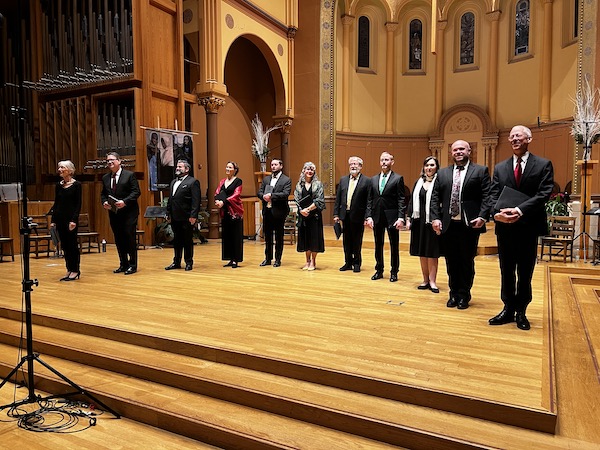Concert Review: Blue Heron Does “Christmas in Medieval England” Right
By Aaron Keebaugh
In this performance, Blue Heron conveyed enough merriment for Christmastime and beyond.

Blue Heron performing Christmas in Medieval England. Photo: courtesy of the artist
Making sense of the sources for the Medieval European repertoire involves both creative license and scholarly concentration. Most manuscripts contain little more than a line of text and a melody, which leaves performers having to fill in the gaps regarding such crucial elements as phrasing, dynamics, and (when appropriate) instrumentation.
Thus listening to this music vis-à-vis Blue Heron, Boston’s acclaimed Renaissance choir, reveals as much about the performers as the music itself. Their recent Christmas in Medieval England program — performed locally for the first time in six years (at the First Church in Cambridge, Congregational) — explored chants, antiphons, mass movements, and Old English carols with almost operatic panache and terpsichorean zeal. And there was plenty of what inevitably comes with any seasonal festivity: mystery and cheer.
In Medieval England, commemoration of Christ’s nativity encompassed Advent, Christmas, Epiphany, and beyond. This was an observance as much as it was a celebration: the season traditionally runs in the liturgical calendar from the Sunday before Christmas to Candlemas on February 2, when believers meditate upon the presentation of Christ at the Temple and celebrate the feast of Purification of the Virgin Mary.
Blue Heron and its director Scott Metcalfe focused on Advent and Christmas. Despite that, there were still a variety of musical styles on vocal display, music from inside and outside of church function. Fresh, spirited carols like “Thys yol the best red that y kan” complemented the reverential tone of the evening’s more resolutely religious pieces. The truth is, even the simplest chants teemed with unexpected vigor, flowering, through spacious harmonies, from soloist and supple trio to full ensemble.
The familiar “Veni, Veni Emanuel,” sung by the men of the choir, cast a dark ambiance as the lines were gradually stacked into ear-stinging resonances. The women answered with the Sarum plainchant “Alma redemptoris mater,” supplying a svelte blend over the tune’s wide angular range.
Throughout, the chants’ dance-like energy mesmerized. “Veni redemptor gencium,” another Sarum plainchant, channeled as much elation as veneration for the divine. Larger works built upon chant also embraced a mirthful ardor. Leonel Power’s “Gloria,” found in the Old Hall manuscript, tittered down to every hocket effect as the singers’ throatier resonance generated powerful gravitas. An anonymous Sanctus from Missa Veterem hominem (ca. 1440) was just as exhilarating, its melismas woven together into a silvery tapestry of sound.
Several of Blue Heron’s fine singers were given the solo spotlight. Sophie Michaux’s chocolatey mezzo-soprano made “Angelus ad virginem” (from the Arundel manuscript) float into the air like a fervent prayer. Clare McNamara sang “Ave Maria I say” with fervid intensity. Kim Leeds’s soprano contributed a bell-toned resonance when she joined Michaux and McNamara in the radiant lullaby, “Lollay lollay.”
Together, the full ensemble assembled a rich blend out of the simplest musical structures. “Hail Mary ful of grace” glowed in hymnic serenity as the antiphonal phrases passed around the choir.
Other works, like the “Agnus Dei” from Missa Veterem hominem, probed the expressive depths of medieval polyphony. Intermingling lines provided a sturdy frame on which the singers hung ringing harmonies.
Instrumentalists Laura Jeppesen (rebec), Charles Weaver (lute), and Scott Metcalfe (harp) gently supported the singers in several pieces. In “Ave Maria I say” they answered the sung verses with graceful assurance, like a thread of silver adorning a golden crown. Metcalfe’s harp spun gleaming lines around Michaux’s in “Angelus ad virginem.”
This was not just a matter of technique triumphant. The group’s joy and exuberance matched the evening’s vocal color and beauty. “Nowel syng we bothe al and som” lilted with the excitement of a child on Christmas morning. So too did the encore of “Nova Nova! Ave fit ex Eva,” where the full cast conveyed enough merriment for Christmastime and beyond. May your holiday season be just as warm, reflective, and invigorating as this performance!
Aaron Keebaugh has been a classical music critic in Boston since 2012. His work has been featured in the Musical Times, Corymbus, Boston Classical Review, Early Music America, and BBC Radio 3. A musicologist, he teaches at North Shore Community College in both Danvers and Lynn.
Tagged: Blue Heron, Charles Weaver, Christmas in Medieval England, Clare McNamara, Laura Jeppesen, Scott Metcalfe

